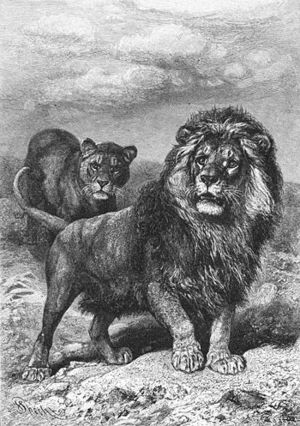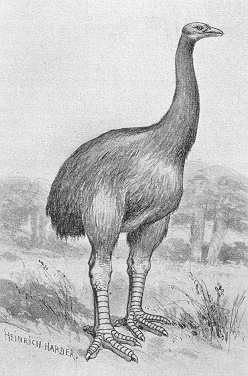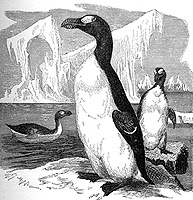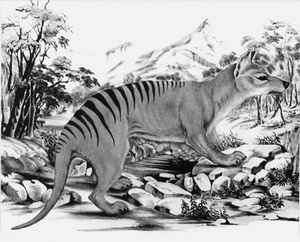全新世灭绝的时间轴
编辑
这个灭绝时间表是现代人类占领地球期间灭绝物种的历史记录。
下面是一份选择性的清单,它是通过对近代史上一些著名的灭绝物种中很小一部分(主要是哺乳动物)进行采样而制成的。然而,绝大多数灭绝事件被认为是没有记录的。根据物种面积理论和上界估计,目前的灭绝率可能高达每年140,000个物种。[1]
目录编辑
1 公元前第10千年编辑
- c. 公元前9950年- 洪堡居维象 在智利存活到大约这个时候。
- c. 公元前9940年- 海鹦中的Fratercula dowi 在海峡群岛存活到大约这个时候。
- c. 公元前9680年- 灌木牛 在犹他州存活到大约这个时候。
- c. 公元前9650年- 南美巨型短面熊属下的Arctotherium tarijense 在乌拉圭存活到大约这个时候。
- c. 公元前9530年- 巨型短面熊 在俄亥俄州存活到大约这个时候。
- c. 公元前9400年- 科西嘉和撒丁岛的犬科下的Cynotherium sardous 存活到大约这个时候。
- c. 公元前9390年- 泛美地懒中的Eremotherium laurillardi 在巴西存活到大约这个时候。
- c. 公元前9380年- Stockoceros 在新墨西哥州幸存到大约这个时候。 墨西哥马 在亚伯达幸存到大约这个时候。
- c. 公元前9220年- 叉角羚 在新墨西哥州存活到大约这个时候。 斯科蒂野马 存活到大约这个时候。
- c. 公元前9180年- 古风野牛 在亚伯达存活到大约这个时候。
- c. 公元前9150年- 林地麝牛Symbos 在密歇根存活到大约这个时候。[2]
- c. 公元前9135年- 美洲豹 存活到大约这个时候。
- c. 公元前9110年- 平头猪属中的Platygonus compressus 在俄亥俄州存活到大约这个时候。
- c. 公元前9090年- 陵角懒 和 剑乳齿象 在巴西存活到大约这个时候。[3]
- c. 公元前9080年- 侏儒猛犸象 在圣罗莎岛(加利福尼亚州)存活到大约这个时候。
- c. 公元前9030年- Bootherium bombifrons 在亚伯达存活到大约这个时候。
2 公元前第9千年编辑
3 公元前第8千年编辑
- c. 公元前7930年- 潘帕斯草原Holmesina 在佛罗里达存活到大约这个时候,[4] 和舌懒兽属 一样。 貘中的Tapirus veroensis 和 粗腿美洲驼 存活到大约这个时候。[5]
- c. 公元前7890年- 与树懒中的沙塔氏孽子兽 相关的木乃伊皮肤表明该物种可能在新墨西哥州存活到大约这个时候。[5]
- c. 公元前7630年- 树懒中的Catonyx cuvieri 在巴西存活到大约这个时候。[6][6]
- c. 公元前7490年- 杰氏巨爪地懒 存活到大约这个时候。[5]
- c. 公元前7490年- 高脚鹿 Sangamona 在密苏里存活到大约这个时候。[6]
- c. 公元前7470年- 塞浦路斯矮象 在这个时候灭绝了。[6]
- c. 公元前7460年- 西貒中的古猯属 在田纳西州存活到大约这个时候。[7] 致命刃齿虎 存活到大约这个时候。[5]
- c. 公元前7450年- 可怕的恶狼中的恐狼 在密苏里生存到大约这个时候。它的灭绝可能是与现存灰狼 的竞争导致的。[7]
- c. 公元前7290年- 塞浦路斯侏儒河马 大约在这个时候灭绝了。[6]
- c. 公元前7180年- 毁灭刃齿虎 在巴西存活到大约这个时候。[6]
4 公元前第7千年编辑
- c. 公元前6960年- Scelidodon chiliensis 在秘鲁存活到大约这个时候。[7]
- c. 公元前6910年- 原始野牛在泰梅尔半岛存活到这个时候。[7]
- c. 公元前6730年- 哥伦比亚猛犸象 在萨斯喀彻温省存活到大约这个时候。[7] 野马Equus santaelenae 在厄瓜多尔存活到大约这个时候。[7]
- c. 公元前6720年- 圣诞岛鼠兔 在北美东部存活到大约这个时候。[7]
- c. 公元前6689年- 磨齿兽 在智利存活到大约这个时候。[8]
- c. 公元前6577年- Hemiauchenia 在内华达州存活到这个时候。[8]
- c. 公元前6290年- 骆驼中的拟驼 在亚利桑那州存活到大约这个时候。[8]
- c. 公元前6275年- 岛雕鸮 存活到大约这个时候。[7]
- c. 公元前6050年- 伟羚中的Megalotragus priscus 在南非存活到大约这个时候。[7]
5 公元前第6千年编辑
6 公元前第5千年编辑
8 公元前第3千年编辑
- c. 公元前2915年- 犬科动物福克兰狼最近的亲缘种Dusicyon avus 在阿根廷存活到大约这个时候。[9]
- c. 公元前2835年- 巴利阿里洞穴山羊大约在这个时候灭绝了。[9]
- c. 公元前2765年- 北非长角水牛 存活到大约这个时候。它的灭绝可能是由于与家牛争夺食物和水造成的。[9]
- c. 公元前2550年- 贝努鸟苍鹭在这一时期灭绝,可能是因为其湿地栖息地退化导致。它最后一次被记录是在阿拉伯半岛。[9]
- c. 公元前2441年- 树懒 中的Neocnus comes 在海地存活到大约这个时候。[9]
- c. 公元前2240年- 树懒中的Megalocnus rodens 和古巴洞穴秧鸡 在古巴存活到这个时候。[9]
9 公元前第2千年编辑
10 公元前第1千年编辑
- c. 公元前790年- 冢雉属中的 Megapodius alimentum 在汤加存活到大约这个时候。[10]
- c. 公元前530年- 微尾金刚鹦鹉 在马达加斯加岛存活到大约这个时候。
- c. 公元前457年- 啮齿动物斜弹齿龙 在波多黎各存活到大约这个时候。
- c. 公元前450年- 产香麝鼩 在埃及存活到大约这个时候。
- c. 公元前341年- 封氏古大狐猴 在马达加斯加岛存活到大约这个时候。
- c. 公元前195年- Xenothrix mcgregori 存活到大约这个时候。[11]
- c. 公元前110年- 古大狐猴 在马达加斯加存活到大约这个时候。
- c. 公元前100年- 叙利亚大象因为过度捕猎象牙而灭绝。[12]
- c. 公元前30年- 岛鹃属的Coua primaeva 在马达加斯加岛存活到大约这个时候。
11 公元后第1千年编辑
11.1 2世纪
- c. 100年- 毛伊高地的鹮类 在毛伊岛存活到这个时候。[13]
11.2 3世纪
11.3 4世纪
- c. 300年- 北非大象一直存活到这个时候。[13]
11.4 5世纪
- c. 450年- 海龟属中的卷角龟 在新喀里多尼亚存活到这个时候。[14]
11.5 6世纪
- c. 537年- 巨型狐猴中的Hadropithecus stenognathus 在马达加斯加岛存活到大约这个时候。[13]
- c. 540年- 类人中原狐猴 在马达加斯加岛存活到大约这个时候。[13]
- c. 570年- 鹭属中的Alopochen sirabensis 在马达加斯加岛存活到大约这个时候。[13]
11.6 7世纪
- c. 685年- 剪水鹱属 存活到大约这个时候。[13]
11.7 8世纪
11.8 9世纪
11.9 10世纪
12 公元后第2千年编辑
12.1 12世纪
- c. 1180年- 毛伊努伊丢失的家禽Maui Nui moa-nalo存活到这个时候。[16]所述的MOA-nalo是大型鸭子和夏威夷群岛的主要食草动物。[16]
- c. 1190年- 亨特岛企鹅 存活到大约这个时候。[16]
12.2 14世纪
- c. 1320年- 狐猴属中的爱氏巨狐猴 在马达加斯加岛存活到这个时候。[16]
- c. 1322年- 高地恐鸟 在新西兰的南岛存活到这个时候。[16]
- c. 1326年- 曼特尔恐鸟 在新西兰的北岛存活到这个时候。[16]
- c. 1360年- 岛鼯 在古巴存活到大约这个时候。[17]
12.3 15世纪
- c. 1400年- 新西兰的哈斯特鹰,一只巨大的猛禽,灭绝了。鹰的主要猎物是各种各样的恐鸟,它们也灭绝了。[17]
- c. 1420年- 南岛巨型恐鸟 在新西兰的南岛存活到大约这个时候。[16]
- c. 1440年- 狐猴属中的古原狐猴 在马达加斯加岛存活到大约这个时候。[16]
- 新西兰的恐鸟灭绝了,可能是因为狩猎导致的。[18]
12.4 16世纪
- c. 1500-1550年- 新西兰南岛的怀塔哈企鹅 灭绝了。[18]
12.5 17世纪
- 1627年- 最后一只已知的西欧野牛在波兰死去。这种大型野生牛以前栖息在欧洲、北非、中东、中亚和印度的大部分地区。[19]
- c. 1645年- 芬奇鸭在新西兰存活到大约这个时候。[16]
- 1662年- 最后一次明确看到渡渡鸟是在毛里求斯。[18]它的灭绝一方面是狩猎导致的,也是由殖民者带到岛上的猪、老鼠、狗和猫造成的。该物种已经成为动物灭绝的标志性象征。[20]
- 大象鸟最后一次被记录是在17世纪末。[18]
12.6 18世纪
- 1768年- 由于过度捕猎肉类和皮革,斯特拉海牛灭绝了。[16][21]
- 1773年- 在老鼠被引入社会群岛的栖息地后,大溪地矶鹬 灭绝了。[22]
- 1774年- 由于入侵物种(狐狸、猫等)被引入撒丁岛和科西嘉岛,意大利鼠兔灭绝了。[23]
- 1777年- 在船只排放害虫后,社会上的鹦鹉种群在社会群岛灭绝。[24]
- 1790年- 新不列颠紫水鸡,也被称为白秧鸡,灭绝了。[25]
12.7 19世纪
- 1800年- 最后一只已知的蓝马羚 被射杀,这使得该物种成为第一个被欧洲殖民者猎杀至灭绝的非洲羚羊。[26]
- 1825年- 太平洋辉惊鸟灭绝了。[27]
- 1826年- 由于过度狩猎,毛里求斯蓝鸠 灭绝了。[28]
- 1827年- 汤加地石龙子从其在汤加群岛的唯一家园灭绝。[29]
- 1852年- 最后一次看到大海雀 是在纽芬兰海岸。这只鸟因寻找脂肪、羽毛、肉和油而濒临灭绝。[18][30]
- 1860年- 由于栖息地的破坏,圣赫勒拿岛的弦乐树 灭绝。[31]
- 1860年- 缅因州海鼬 因为捕猎皮毛而灭绝。[32]
- 1875年- 宽脸袋鼠最后一次被记录。[16]
- 1876年- 福克兰群岛狼灭绝了。[16]
- 1878年- 三年前最后一次出现在长岛后,拉布拉多鸭 宣布灭绝。[33]
- 1879年- 非洲唯一的本土熊,阿特拉斯棕熊,其最后一只被摩洛哥的猎人杀死。在罗马帝国时,这种熊被大量猎杀并用于体育运动。[34]
- 1880年- 美国和加拿大的麋鹿亚种——马鹿 被宣布灭绝。[35]
- 1883年- 平原斑马的一个亚种——南非斑驴 灭绝了。[36]
- 1886年- 澳大利亚被称为贝内特海藻 的红藻因为大量的人类活动而消失。[37]
- 1889年- 最后一个北海道狼 死于中毒事件。[38]
- 1890年- 褐兔袋鼠 最后一次被记录下来。[16]
12.8 20世纪
20世纪初
- 1902年- 落基山蝗虫 的最后已知标本是在布兰登曼尼托巴省附近采集的。[39]
- 1905年- 日本最后一只已知的倭狼 死在奈良县。[40]
- 1907年- 最后一次见到新西兰的本地鸟——兼嘴垂耳鸦。栖息地的丧失、狩猎和疾病都是其灭绝的原因。[41]
- 1909年- 最后一只已知的波兰野马——欧洲野马在囚禁中死去。[42]
20世纪10年代
- 1911年- 最后一只纽芬兰狼 被枪杀。[38]
- 1914年- 最后一只候鸽 ——玛莎在辛辛那提动物园死于囚禁。过度狩猎导致了它的灭绝;它以前是世界上数量最多的鸟类之一。[43]
- 1918年- 最后一个卡罗莱纳长尾鹦鹉 在辛辛那提动物园死于囚禁。这种鸟以前生活在美国东南部,由于开发、砍伐森林和与外来蜜蜂的竞争,它被灭绝了。[44]
20世纪20年代
- 1924年- 加利福尼亚大灰熊 最后一次被看到。[45]
- 1925年- 基奈山狼 被逼灭绝。[38]
- 1929年- 怀氏铁苋菜 最后一次出现在野外。这个物种可能是A.raivavensis 和 A.tubuaiensis 的同义词,这意味着它实际上并没有在全球范围内灭绝。[46]
20世纪30年代
- 1930年- 达尔文氏稻鼠 最后一次被记录是在加拉帕戈斯群岛。它的灭绝可能是由于引入了黑鼠。[47]
- 1932年-“Booming Ben”,最后一只已知的新格兰黑琴鸡 出现在马萨诸塞州的玛莎葡萄园岛上。[48][49]
- 1933年- 来自欧洲的三色堇 因为栖息地丧失和在其唯一生长地(法国)的过度采集而灭绝。[50]
- 1934年- 不屈不挠的加拉帕戈斯老鼠最后一次被记录下来。它的灭绝可能是因为引入了黑鼠。[51]
- 1935年- 沙漠兔袋鼠最后一次被记录。[16]
- 1935年- 蒙古狼 和南落基山狼 被猎杀至灭绝。[38]
- 1936年- 最后一只袋狼 死在囚禁中。狩猎、栖息地丧失、疾病和家犬的竞争都可能导致了该物种的灭绝。[52]
- 1937年- 最后一次明确地看到巴厘虎 是在这个时候,但此物种存在很可能持续到了20世纪40年代,甚至可能是50年代初。[53]
- 1939年- 图拉克袋鼠最后一次被记录到。[16]
20世纪40年代
20世纪50年代
- 1952年- 加勒比僧海豹 的最后一份可靠报告。[55]
- 1952年- 伯纳德的狼被猎杀到灭绝。[38]
- 1956年- 新月甲尾袋鼠和帝啄木鸟 最后一次被记录下来。[16]
- 1957年- 特氏石𫚔,一种鱼类,最后一次被采集。[56]
20世纪60年代
- 1960年- 墨西哥灰熊 在这个时候灭绝了。[57]
- 1962年- 红腹薄腹负鼠最后一次被记录是在阿根廷。[16]
- 1964年- 夏威夷群岛的夏威夷谷壳花 因为栖息地丧失而灭绝。[58]
- 1965年- 最后一次看到肿胀花育珠蚌,它是一种美国贻贝。[59]
- 1966年- 最后一个阿拉伯鸵鸟 在这个时候去世。[60]
20世纪70年代
- 1970年- 里海虎 主要由于栖息地丧失、狩猎和猎物丢失而灭绝。[61]
- 1972年- 牙买加特有的梅森河香桃木灭绝了。[62]
- 1974年- 最后一个已知的日本海狮 在北海道瑞文岛海岸被抓获。[63]
- c.1976年- 最后一次看到爪哇虎。[64]
20世纪80年代
- 1981年- 木槿花中的Puhielelu hibiscadelphus 灭绝了。[65]
- 1981年- 最后一次看到绿色花育珠蚌,它是一种美国贻贝。[66]
- 1981年- 南部胃育蛙 灭绝可能是由于栖息地破坏和疾病。[67]
- 1983年- 最后一次未确认的发现林牛,[68] 最后一次确认发现是在1969/70年。[69] 世界自然保护联盟(IUCN)宣布它“最有可能灭绝”。[69]
- 1983-84年- 24射线海星,加拉帕戈斯黑色斑点雀鲷和加拉帕戈斯串穗杂草可能会因为气候变化而灭绝。[70]
- 1985年- 北部胃育蛙 灭绝可能是由于栖息地破坏和疾病。[71]
- 1987年- 最后一个奥亚吸蜜鸟 是一个雄性,记录下它唱求偶歌。此后,这一物种再也没有听说过,并被宣布灭绝。[72]
- 1989年- 哥斯达黎加的金蟾蜍 灭绝了,可能是因为气候变化导致。[73]
20世纪90年代
13 公元后第3千年编辑
13.1 21世纪
21世纪初
- 2000年- 最后一只庇里牛斯野山羊,名叫“西莉亚”,于2000年被发现死亡。然而,在2003年,一名女性将它克隆回来,但是它出生后不久就死于肺部缺陷。[78][79]
- 2003年- 种植中的圣赫勒拿橄榄树 的最后一个个体死亡。最后一株野生植物于1994年死亡。[80]
- 2006年- 一项技术先进的长江调查未能找到白鳍豚 的标本,促使科学家宣布白鳍豚功能性灭绝。[81]
2010s
- 2011年- 东部美洲狮 宣布灭绝。最后一个已知个体是在1938年被困杀而死的。[82][83]
- 2011年- 西部黑犀牛宣布灭绝。[84]
- 2012年- 在30多年不见日本水獭 之后,它被国家环境部宣布灭绝。[85]
- 2012年- 叫作“孤独乔治”的平塔岛象龟 的最后一个已知标本,于2012年6月24日死亡。[86]
- 2013年- 佛得角巨石龙子 宣布灭绝。[87]
- 2013年- 以前台湾岛特有的台湾云豹 正式宣布灭绝。[88]
- 2014年- 百慕大白鲸 自2012年被化石描述后便宣布灭绝。[89]
- 2017年- 在最后一个已知标本死亡三年后,圣诞岛森林石龙子 宣布灭绝。[90]
- 2019年- 珊瑚裸尾鼠 宣布灭绝。[91]
参考文献
- [1]
^S.L. Pimm, G.J. Russell, J.L. Gittleman and T.M. Brooks, The Future of Biodiversity, Science 269: 347–350 (1995).
- [2]
^Martin & Klein 1989, p. 81..
- [3]
^Martin & Klein 1989, p. 85..
- [4]
^Martin & Klein 1989, p. 51..
- [5]
^Kurtén, Björn; Anderson, Elaine (1980). Pleistocene mammals of North America. Columbia University Press. pp. 364–65. ISBN 978-0-231-03733-4. Retrieved 29 February 2012..
- [6]
^Martin & Klein 1989, p. 75..
- [7]
^Martin & Klein 1989, p. 55..
- [8]
^Martin & Klein 1989, p. 446..
- [9]
^Steadman, David W.; Martin, Paul S.; MacPhee, Ross D. E.; Jull, A. J. T.; McDonald, H. Gregory; Woods, Charles A.; Iturralde-Vinent, Manuel; Hodgins, Gregory W. L. (August 16, 2005). "Asynchronous extinction of late Quaternary sloths on continents and islands". Proceedings of the National Academy of Sciences of the United States of America. 102 (33): 11763–8. doi:10.1073/pnas.0502777102. PMC 1187974. PMID 16085711..
- [10]
^Steadman, David W.; Pregill, Gregory K.; Burley, David V. (March 19, 2002). "Rapid prehistoric extinction of iguanas and birds in Polynesia". Proceedings of the National Academy of Sciences of the United States of America. 99 (6): 3673–7. doi:10.1073/pnas.072079299. PMC 122582. PMID 11904427..
- [11]
^Cooke, Siobhán B.; Rosenberger, Alfred L.; Turvey, Samuel (February 15, 2011). "An extinct monkey from Haiti and the origins of the Greater Antillean primates". Proceedings of the National Academy of Sciences of the United States of America. 108 (7): 2699–704. doi:10.1073/pnas.1009161108. PMC 3041101. PMID 21282603..
- [12]
^Choudhury, A., Lahiri Choudhury, D.K., Desai, A., Duckworth, J.W., Easa, P.S., Johnsingh, A.J.T., Fernando, P., Hedges, S., Gunawardena, M., Kurt, F., Karanth, U., Lister, A., Menon, V., Riddle, H., Rübel, A. & Wikramanayake, E. (IUCN SSC Asian Elephant Specialist Group) (2008). "Elephas maximus". The IUCN Red List of Threatened Species. 2008: e.T7140A12828813. doi:10.2305/IUCN.UK.2008.RLTS.T7140A12828813.en.CS1 maint: Multiple names: authors list (link).
- [13]
^name=https://scoopempire.com/7-extinct-animals-that-once-lived-in-north-africa/“.
- [14]
^MacPhee, R.D. E. (1999). Extinctions in near time: causes, contexts, and consequences. Springer. pp. 19–28, 394. ISBN 978-0-306-46092-0. Retrieved 29 February 2012..
- [15]
^Turvey, S.T; Oliver, J.R; Storde, Y.M Narganes; Rye, P (April 22, 2007). "Late Holocene extinction of Puerto Rican native land mammals". Biology Letters. 3 (2): 193–6. doi:10.1098/rsbl.2006.0585. PMC 2375922. PMID 17251123..
- [16]
^Turvey, Sam (2009). Holocene extinctions. Oxford University Press. pp. 20–33, 42–50, 64–94, 352. ISBN 978-0-19-953509-5. Retrieved 29 February 2012..
- [17]
^Haynes, Gary (2009). American megafaunal extinctions at the end of the Pleistocene. Springer. pp. 23, 27–31, 133, 152–53, 172. ISBN 978-1-4020-8792-9. Retrieved 28 February 2012..
- [18]
^Adams, Jonathan; Adams, Jonathan S. (2009). Species richness: patterns in the diversity of life. Springer. pp. 239–55. ISBN 978-3-540-74277-7. Retrieved 28 February 2012..
- [19]
^Tikhonov, A. (2008). "Bos primigenius". The IUCN Red List of Threatened Species. 2008: e.T136721A4332142. doi:10.2305/IUCN.UK.2008.RLTS.T136721A4332142.en..
- [20]
^Raphus cucullatus Archived 14 5月 2007 at the Wayback Machine at the Recently Extinct Animals website.
- [21]
^Domning, D.; Anderson, P.K.; Turvey, S. (2008). Hydrodamalis gigas. IUCN Red List of Threatened Species 2010. International Union for Conservation of Nature..
- [22]
^BirdLife International (2008). "Prosobonia leucoptera (Tahitian Sandpiper)", iucnredlist.org; retrieved 29 February 2012..
- [23]
^Smith, A.T. & Johnston, C.H. (2008). "Prolagus sardus". The IUCN Red List of Threatened Species. 2008: e.T18338A8103116. doi:10.2305/IUCN.UK.2008.RLTS.T18338A8103116.en.CS1 maint: Multiple names: authors list (link).
- [24]
^BirdLife International (2016). "Cyanoramphus ulietanus". The IUCN Red List of Threatened Species. 2016: e.T22728673A94993704. doi:10.2305/IUCN.UK.2016-3.RLTS.T22728673A94993704.en..
- [25]
^BirdLife International (2016). "Porphyrio albus". The IUCN Red List of Threatened Species. 2016: e.T22692801A93370193. doi:10.2305/IUCN.UK.2016-3.RLTS.T22692801A93370193.en..
- [26]
^IUCN SSC Antelope Specialist Group (2008). "Hippotragus leucophaeus (Bluebuck, Blue Buck)", iucnredlist.org; retrieved 29 February 2012..
- [27]
^BirdLife International (2016). "Aplonis mavornata". The IUCN Red List of Threatened Species. 2016: e.T22710499A94248417. doi:10.2305/IUCN.UK.2016-3.RLTS.T22710499A94248417.en..
- [28]
^BirdLife International (2016). "Alectroenas nitidissimus". The IUCN Red List of Threatened Species. 2016: e.T22691601A93318208. doi:10.2305/IUCN.UK.2016-3.RLTS.T22691601A93318208.en..
- [29]
^Allison, A., Hamilton, A. & Tallowin, O. (2012). "Tachygyia microlepis". The IUCN Red List of Threatened Species. 2012: e.T21286A2775072. doi:10.2305/IUCN.UK.2012.RLTS.T21286A2775072.en.CS1 maint: Multiple names: authors list (link).
- [30]
^BirdLife International (2008). "Pinguinus impennis (Great Auk)", iucnredlist.org; retrieved 29 February 2012..
- [31]
^Lambdon, P.W. & Ellick, S. (2016). "Acalypha rubrinervis". The IUCN Red List of Threatened Species. 2016: e.T37854A67371775. doi:10.2305/IUCN.UK.2016-1.RLTS.T37854A67371775.en.CS1 maint: Multiple names: authors list (link).
- [32]
^Helgen, K. & Turvey, S.T. (2016). "Neovison macrodon". The IUCN Red List of Threatened Species. 2016: e.T40784A45204492. doi:10.2305/IUCN.UK.2016-1.RLTS.T40784A45204492.en.CS1 maint: Multiple names: authors list (link).
- [33]
^BirdLife International (2016). "Camptorhynchus labradorius". The IUCN Red List of Threatened Species. 2016: e.T22680418A92862623. doi:10.2305/IUCN.UK.2016-3.RLTS.T22680418A92862623.en..
- [34]
^"Ursus arctos crowtheri". Prehistoric Wildlife. Retrieved 6 June 2015..
- [35]
^U.S. Fish and Wildlife Service (2016). "Cervus canadensis canadensis (Eastern Elk)" , fws.gov; retrieved 23 June 2017..
- [36]
^King, S.R.B. & Moehlman, P.D. (2016). "Equus quagga". The IUCN Red List of Threatened Species. 2016: e.T41013A45172424. doi:10.2305/IUCN.UK.2016-2.RLTS.T41013A45172424.en.CS1 maint: Multiple names: authors list (link).
- [37]
^Millar, A.J.K. (Royal Botanic Gardens Sydney, Australia) (2003). "Vanvoorstia bennettiana". The IUCN Red List of Threatened Species. 2003: e.T43993A10838671. doi:10.2305/IUCN.UK.2003.RLTS.T43993A10838671.en.CS1 maint: Multiple names: authors list (link).
- [38]
^Wolves, wolfhowl.org; accessed 27 April 2016..
- [39]
^"The Mysterious Disappearance of the Rocky Mountain Locust". Retrieved 6 June 2015..
- [40]
^"The Honshu Wolf". bib.ge. Retrieved 25 February 2016..
- [41]
^BirdLife International (2017). "Heteralocha acutirostris". The IUCN Red List of Threatened Species. 2017: e.T22708091A119257859. doi:10.2305/IUCN.UK.2017-3.RLTS.T22708091A119257859.en..
- [42]
^Bunzel-Drüke, M., C. Böhm, P. Finck, G. Kämmer, R. Luick, E. Reisinger, U. Riecken, J. Riedl, M. Scharf & O. Zimball: “Wilde Weiden. Praxisleitfaden für Ganzjahresbeweidung in Naturschutz und Landschaftsentwicklung.” Bad Sassendorf-Lohne: Arbeitsgemeinschaft Biologischer Umweltschutz im Kreis Soest e.V., 2008. (pdf, 300 MB).
- [43]
^Ectopistes migratorius. IUCN Red List of Threatened Species 2013.2. International Union for Conservation of Nature. 2012. Retrieved 26 November 2013..
- [44]
^Conuropsis carolinensis. IUCN Red List of Threatened Species 2013.2. International Union for Conservation of Nature. 2012. Retrieved 26 November 2013..
- [45]
^"Grizzly Bear". Valley Center History Museum. Retrieved 6 June 2015..
- [46]
^de Lange, P., Martin, T. & McCormack, G. (2014). "Acalypha wilderi". The IUCN Red List of Threatened Species. 2014: e.T199821A2612719. doi:10.2305/IUCN.UK.2014-1.RLTS.T199821A2612719.en.CS1 maint: Multiple names: authors list (link).
- [47]
^Tirira, D., Dowler, R., Boada, C. & Weksler, M. (2008). "Nesoryzomys darwini". The IUCN Red List of Threatened Species. 2008: e.T14706A4456400. doi:10.2305/IUCN.UK.2008.RLTS.T14706A4456400.en.CS1 maint: Multiple names: authors list (link).
- [48]
^BirdLife International (2016). "Tympanuchus cupido". The IUCN Red List of Threatened Species. 2016: e.T22679514A92817099. doi:10.2305/IUCN.UK.2016-3.RLTS.T22679514A92817099.en..
- [49]
^Rebecca Heisman (2016). "Tympanuchus cupido cupido (Heath Hen)" , jstor.org; retrieved 23 June 2017..
- [50]
^Juillet, N. (2011). "Viola cryana". The IUCN Red List of Threatened Species. 2011: e.T165210A5990668. doi:10.2305/IUCN.UK.2011-1.RLTS.T165210A5990668.en..
- [51]
^Tirira, D., Dowler, R., Boada, C. & Weksler, M. (2008). "Nesoryzomys indefessus". The IUCN Red List of Threatened Species. 2008: e.T14708A4456597. doi:10.2305/IUCN.UK.2008.RLTS.T14708A4456597.en.CS1 maint: Multiple names: authors list (link).
- [52]
^M. McKnight (2008). Thylacinus cynocephalus. IUCN Red List of Threatened Species 2010. International Union for Conservation of Nature..
- [53]
^Jackson, P. & Nowell, K. (2008). "Panthera tigris balica (Bali Tiger)" , iucnredlist.org; retrieved 23 June 2017..
- [54]
^Black, Simon A.; Fellous, Amina; Yamaguchi, Nobuyuki; Roberts, David L. (2013). "Examining the Extinction of the Barbary Lion and Its Implications for Felid Conservation". PLOS ONE. 8 (4): e60174. doi:10.1371/journal.pone.0060174..
- [55]
^Lowry, L. (2015). "Neomonachus tropicalis". The IUCN Red List of Threatened Species. 2015: e.T13655A45228171. doi:10.2305/IUCN.UK.2015-2.RLTS.T13655A45228171.en..
- [56]
^NatureServe (2013). "Noturus trautmani". The IUCN Red List of Threatened Species. 2013: e.T14908A19032932. doi:10.2305/IUCN.UK.2013-1.RLTS.T14908A19032932.en..
- [57]
^McLellan, B.N., Proctor, M.F., Huber, D. & Michel, S (2017). "Ursus arctos". The IUCN Red List of Threatened Species. 2017: e.T41688A121229971. doi:10.2305/IUCN.UK.2017-3.RLTS.T41688A121229971.en.CS1 maint: Multiple names: authors list (link).
- [58]
^Bruegmann, M.M. & Caraway, V. (2003). "Achyranthes atollensis". The IUCN Red List of Threatened Species. 2003: e.T44074A10847953. doi:10.2305/IUCN.UK.2003.RLTS.T44074A10847953.en.CS1 maint: Multiple names: authors list (link).
- [59]
^"Three American mussel species become extinct". mongabay.com. 10 August 2008. Archived from the original on 7 January 2010. Retrieved 4 January 2010..
- [60]
^BirdLife International (2016). "Struthio camelus". The IUCN Red List of Threatened Species. 2016: e.T45020636A95139620. doi:10.2305/IUCN.UK.2016-3.RLTS.T45020636A95139620.en..
- [61]
^Jackson, P. & Nowell, K. (2011). "Panthera tigris virgate (Caspian Tiger)" , iucnredlist.org; retrieved 23 June 2017..
- [62]
^Kelly, D.L. (1998). "Myrcia skeldingii". The IUCN Red List of Threatened Species. 1998: e.T33796A9805664. doi:10.2305/IUCN.UK.1998.RLTS.T33796A9805664.en..
- [63]
^"Zalophus californianus japonicus (CR)". Japanese Ministry of the Environment. Retrieved 8 June 2015..
- [64]
^Jackson, P. & Nowell, K. (2008). "Panthera tigris sondaica (Javan Tiger)" , iucnredlist.org; retrieved 23 June 2017..
- [65]
^World Conservation Monitoring Centre (1998). "Hibiscadelphus crucibracteatus". The IUCN Red List of Threatened Species. 1998: e.T33556A9793280. doi:10.2305/IUCN.UK.1998.RLTS.T33556A9793280.en..
- [66]
^Bogan, A.E. (Mollusc Specialist Group) (2000). "Epioblasma torulosa gubernaculum (Green-Blossom Pearly Mussel)" , iucnredlist.org; retrieved 23 June 2017..
- [67]
^Ed Meyer, David Newell, Harry Hines, Sarah May, Jean-Marc Hero, John Clarke, Frank Lemckert (2004). "Rheobatrachus silus". The IUCN Red List of Threatened Species. 2004: e.T19475A8896430. doi:10.2305/IUCN.UK.2004.RLTS.T19475A8896430.en.CS1 maint: Multiple names: authors list (link).
- [68]
^"Search for the kouprey: trail runs cold for Cambodia's national animal". Phnom Penh Post, April 2006..
- [69]
^Timmins, R.J.; Hedges, S.; Duckworth., J.W. (2008). Bos sauveli. IUCN Red List of Threatened Species 2008. International Union for Conservation of Nature...
- [70]
^Hance, Jeremy (3 December 2009). "Extinctions on the rise in the Galapagos: fishing and global warming devastating islands' species". mongabay.com. Retrieved 27 April 2016..
- [71]
^Jean-Marc Hero, Keith McDonald, Ross Alford, Michael Cunningham, Richard Retallick (2004). "Rheobatrachus vitellinus". The IUCN Red List of Threatened Species. 2004: e.T19476A8897826. doi:10.2305/IUCN.UK.2004.RLTS.T19476A8897826.en.CS1 maint: Multiple names: authors list (link).
- [72]
^BirdLife International (2016). "Moho braccatus". The IUCN Red List of Threatened Species. 2016: e.T22704323A93963628. doi:10.2305/IUCN.UK.2016-3.RLTS.T22704323A93963628.en..
- [73]
^Savage, J., Pounds, J. & Bolaños, F. (2008). "Incilius periglenes". The IUCN Red List of Threatened Species. 2008: e.T3172A9654595. doi:10.2305/IUCN.UK.2008.RLTS.T3172A9654595.en.CS1 maint: Multiple names: authors list (link).
- [74]
^U.S. Fish and Wildlife Service (2014). "Ammodramus maritimus nigrescens (Dusky Seaside Sparrow)" , fws.gov; retrieved 23 June 2017..
- [75]
^Platenberg, R. & Powell, R. (2016). "Borikenophis sanctaecrucis". The IUCN Red List of Threatened Species. 2016: e.T40791A115177079. doi:10.2305/IUCN.UK.2016-3.RLTS.T40791A71740001.en.CS1 maint: Multiple names: authors list (link).
- [76]
^World Conservation Monitoring Centre (1996). "Levuana irridescens". The IUCN Red List of Threatened Species. 1996: e.T11919A3315160. doi:10.2305/IUCN.UK.1996.RLTS.T11919A3315160.en..
- [77]
^World Conservation Monitoring Centre (1998). "Ormosia howii". The IUCN Red List of Threatened Species. 1998: e.T32433A9706669. doi:10.2305/IUCN.UK.1998.RLTS.T32433A9706669.en..
- [78]
^Herrero, J. & Pérez, J.M (2008). "Capra pyrenaica". The IUCN Red List of Threatened Species. 2008: e.T3798A10085397. doi:10.2305/IUCN.UK.2008.RLTS.T3798A10085397.en.CS1 maint: Multiple names: authors list (link).
- [79]
^Carl Zimmer (2013). "Capra pyrenaica pyrenaica (Pyrenean Ibex)" , nationalgeographic.com; retrieved 23 June 2017..
- [80]
^Lambdon, P.W. & Ellick, S. (2016). "Nesiota elliptica". The IUCN Red List of Threatened Species. 2016: e.T37598A67372241. doi:10.2305/IUCN.UK.2016-1.RLTS.T37598A67372241.en.CS1 maint: Multiple names: authors list (link).
- [81]
^"Lipotes vexillifer". IUCN Red List. February 2012. Retrieved 6 February 2013..
- [82]
^"Eastern cougar declared extinct, confirming decades of suspicion". CNN. 2 March 2011. Retrieved 14 November 2011..
- [83]
^"Eastern Cougar extinct, no longer needs protection, says US conservation agency". The Guardian. 17 June 2015. Retrieved 3 December 2015..
- [84]
^Boettcher, Daniel. "Western black rhino declared extinct". bbc. Retrieved 27 April 2016..
- [85]
^Environment Ministry (2012). "Lutra lutra whiteneyi (Japanese River Otter)" , japantimes.co.jp; retrieved 02 July 2017..
- [86]
^"Lonesome George". Galapagos Conservancy..
- [87]
^Vasconcelos, R. (2013). "Chioninia coctei". The IUCN Red List of Threatened Species. 2013: e.T13152363A13152374. doi:10.2305/IUCN.UK.2013-1.RLTS.T13152363A13152374.en..
- [88]
^"Clouded leopards declared extinct in Taiwan". Tree Hugger. 6 May 2013. Retrieved 27 April 2016..
- [89]
^BirdLife International (2016). "Aegolius gradyi". The IUCN Red List of Threatened Species. 2016: e.T62184893A95192681. doi:10.2305/IUCN.UK.2016-3.RLTS.T62184893A95192681.en..
- [90]
^Cogger, H. & Woinarski, J. (2017). "Emoia natavitatis. The IUCN Red List of Threatened Species 2017". IUCN. doi:10.2305/IUCN.UK.2017-3.RLTS.T178595A101749951.en.CS1 maint: Multiple names: authors list (link).
- [91]
^Woinarski, J. & Burbidge, A.A. (2016). "Melomys rubicola. The IUCN Red List of Threatened Species 2016". doi:10.2305/IUCN.UK.2016-2.RLTS.T13132A97448475.en.CS1 maint: Multiple names: authors list (link).
暂无



